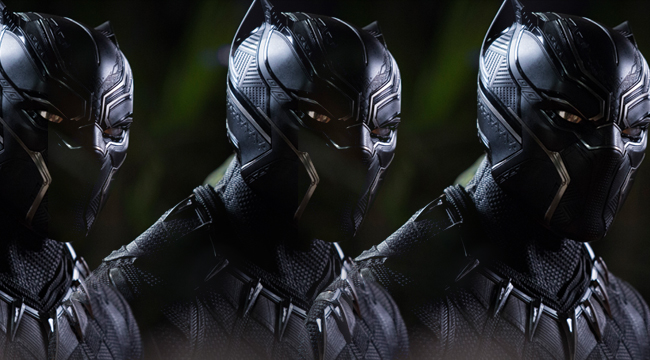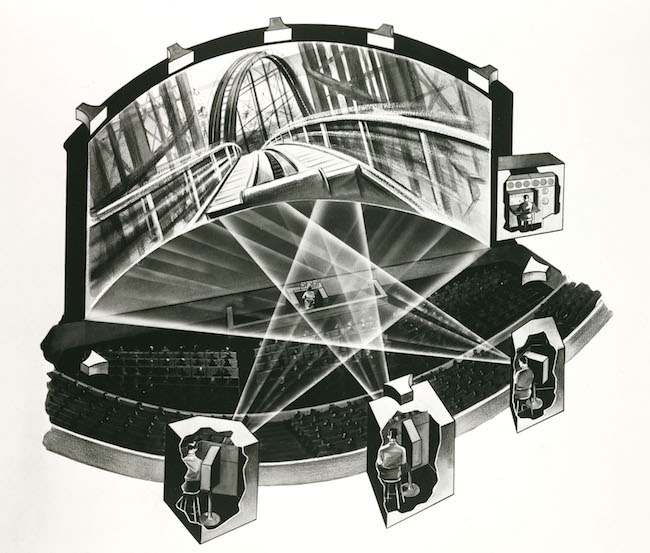
Black Panther certainly doesn’t need any help at the box office. The Marvel Studios release has been setting and breaking records since before it even opened, starting with new highs for Fandango ticket pre-orders. It’s climbed the charts of the all-time highest-grossing Marvel films, superhero films and films in general, and with three weeks at the top of the domestic box-office charts, it shows no signs of stopping those ascents. Clearly, the movie has struck a chord with audiences, who are seeing it for its rich story, complex characters, diverse representation, gorgeous special effects and exciting action.
One record that’s not reported among those various milestones is how much money Black Panther has made in ScreenX, a relatively new exhibition format in which it’s been playing in 100-plus locations in eight countries. Developed by South Korean theater chain CJ CGV, ScreenX is the latest in the grand tradition of theatrical presentation gimmicks designed to get audiences out of their houses and into the movie theater. And like most of the current add-ons to the theatrical experience, from 3D to seat-rumbling D-Box to 4D technologies that bombard audiences with smells and sprays, ScreenX is a high-tech spin on an old format, expanding the image to a 270-degree wraparound that recalls the days of the highly touted (but short-lived) Cinerama process.

Launched in 1952 — when, like now, movie theaters feared competition from other forms of entertainment — Cinerama produced a 146-degree panoramic image via three overlapping projectors on a large curved screen. Only a handful of movies were shot in the true Cinerama process, created with three separate images, most of which were documentaries like the initial 1952 proof-of-concept film This Is Cinerama. In 1962, two narrative films — The Wonderful World of the Brothers Grimm and How the West Was Won — were produced in Cinerama, but in its later days the complicated process was abandoned in favor of using Cinerama as a brand name for 70mm widescreen presentations (much like IMAX is used as a brand name for large-scale, but not truly IMAX-size, theaters today).
Like Cinerama, ScreenX uses three separate images, although they aren’t shown on a single oversized screen. Instead, the main image (that is, what most moviegoers see as the entire movie) is projected on a screen at the front of the theater as normal, while two additional images are projected on either side of the screen, creating what is meant to be an immersive cinema experience. Although ScreenX is prevalent abroad (especially in South Korea, where it was created), only three theaters in the U.S. feature the technology: two in Southern California, and one in Las Vegas. Black Panther is just the third Hollywood movie (following Pirates of the Caribbean: Dead Men Tell No Tales and Kingsman: The Golden Circle) to be shown in ScreenX in the U.S.
I headed to the AMC Town Square in Las Vegas on a Sunday afternoon to catch Black Panther in ScreenX, after having seen the movie once in the traditional format. Tickets for ScreenX shows carry a typical upcharge (the face value of mine was $13.99), and there were around 20 people in the theater for this particular showing. One thing I hadn’t realized before settling into my seat is that, at least at Town Square, the side images are projected directly onto the theater walls, and I briefly worried that I was in the wrong auditorium when I didn’t see additional screens set up.
But I did spot the six projectors near the ceiling on each side of the auditorium, and as soon as the movie started (with the animated prologue detailing the history of Wakanda), the images filled the space, immersing the audience in the mystical past. Or trying to, at least. Because there aren’t any screens on the sides, the sparkling star fields were broken up by glowing green exit signs, and the supplemental images were always a bit distorted and less distinct than the main picture.
Being surrounded by stars was a good way to get drawn into the story from the beginning, though, and it was a bit disappointing when the side images disappeared after the brief prologue ended. All told, the ScreenX experience constituted maybe 25 minutes of the 134-minute movie, broken up into short bursts of about two to three minutes throughout the running time. Although add-ons like ScreenX are often associated with spectacle, the enhancements were just as likely to show up during quiet moments as they were to be deployed during action sequences.
The movie’s first major action beat, when T’Challa (Chadwick Boseman) extricates Nakia (Lupita Nyong’o) from an undercover operation, proceeded without any ScreenX elements, but when T’Challa, Nakia and Okoye (Danai Gurira) were making their approach to Wakanda from the air, the image expanded again, emphasizing the breathtaking vistas of the hidden advanced world. It was probably wiser to utilize the additional images during quiet scenes like that, since looking from side to side at the extra footage made it easy to lose track of the dialogue or plot details.
The tendency for distraction was so great that I worried about anyone in the auditorium seeing the movie for the first time, who wouldn’t come prepared with knowledge of the plot and characters in advance. T’Challa’s coronation, a scene featuring the colorful range of Wakandan life (and also an essential plot-delivery moment), seemed like it would be perfect for a wider view, but the side projectors remained dark until just after, when T’Challa ingests the heart-shaped herb and has a vision of his late father. That’s also a scene full of important exposition, but I’m sure I missed half of the dialogue while looking around me for anything cool on the sides (it was mostly just an expansion of the landscape). Filmmakers can be very deliberate in focusing the audience’s attention, but by adding extra visual elements, ScreenX has the potential to undermine those specific artistic decisions. The audience ends up missing the forest while looking around for the additional trees.
Finally, nearly 50 minutes into the movie, the ScreenX experience took on an action sequence, the car chase through the streets of Busan, South Korea, and nearly justified its presence. It helps that part of the movie’s plot involves an invention by T’Challa’s sister Shuri (Letitia Wright) that allows drivers to control cars and planes remotely, which means that making the audience feel like they are sitting in an immersive first-person driving game actually enhances and complements the narrative. (It’s also probably not a coincidence that the South Korean ScreenX makers spent the most time on augmenting a scene set in South Korea.) Especially when the picture takes on the perspective of Shuri or Nakia as they drive their cars, being surrounded by the extra space puts the audience right in the driver’s seat (or the passenger seat, at least). Still, the seams between the screens remain significant, and anytime an actual figure crosses over from the main action into the supplementary image, the contrast between the quality of the images is obvious.
The car chase was probably the height of the ScreenX experience; the second use of the first-person video-game-style perspective, when Agent Ross (Martin Freeman) is remotely flying a plane above Wakanda to block the weapons being sent to the outside world, was much less effective, since the movie kept cutting back to the massive battle of the various Wakandan armies. That action was clearly far too cluttered to provide an adequate Screen X template, so the side view would blink in and out as the movie switched back and forth, never giving the audience enough time to get immersed in Ross’ viewpoint.
The process was more effective at showcasing action during the second ritual challenge scene, the battle between T’Challa and Killmonger (Michael B. Jordan), even adding a flourish by expanding the image right as Zuri (Forest Whitaker) pounds his staff to begin the fight. And when Ross, Shuri and T’Challa’s mother Ramonda (Angela Bassett) travel through the snowy mountains to the land of the Jabari tribe, the vista opened up as stunningly as it did on the first approach to Wakanda at the beginning of the movie.
As a second viewing experience, watching Black Panther in ScreenX was a bit of goofy fun, but even the most effective moments never actually made the movie better, and the viewing process, always looking from side to side, was cumbersome (I ended up moving from the end of a row to the middle so that I could have a better vantage point). As with other specialty formats (3D, IMAX), the best results would probably come from a movie that was designed from the beginning with ScreenX in mind, by a filmmaker with a particular artistic vision that utilizes the technology. Although given the currently limited ScreenX market, especially in the U.S., it may be quite a while before the format gets its own Michael Bay or James Cameron.
Even Cinerama only achieved a fully realized vision in a couple of narrative feature films, though. These days, Cinerama is looked back on with nostalgia, and events like the Turner Classic Movies Film Festival make painstaking efforts to re-create the outdated technology. Fans clamor to attend these rare screenings, to watch Cinerama films in the way they were originally intended. At Town Square, ScreenX is barely even advertised, and attendees may just be buying tickets to the most conveniently timed screening of Black Panther.
Sitting in the theater, the experience didn’t feel like the dawning of a new age of cinema, even though I had a good enough time with it. It was more comfortable than spending two hours wearing 3D glasses, at least, and it provided some novelty to the moviegoing experience. If given the choice, though, I’d probably stick with the standard version of a ScreenX movie, even for a repeat viewing. It’s hard to imagine ScreenX inspiring the same sort of devotion as Cinerama does years from now, although without refinement, its cheesy, unwieldy presentation indicates that it may have a similarly brief heyday.






